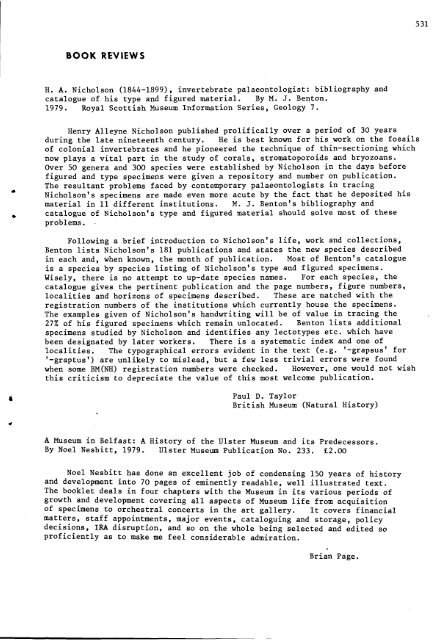E;*+ - Geological Curators
E;*+ - Geological Curators
E;*+ - Geological Curators
Create successful ePaper yourself
Turn your PDF publications into a flip-book with our unique Google optimized e-Paper software.
BOOK REVIEWS<br />
H. A. Nicholson (1844-1899), invertebrate palaeontologist: bibliography and<br />
catalogue of his type and figured material. By M. J. Benton.<br />
1979. Royal ScottishMuseum Information Series, Geology 7.<br />
Henry Alleyne Nicholson published prolifically over a period of 30 years<br />
during the late nineteenth century. He is best known for his work on the fossils<br />
of colonial invertebrates and he pioneered the technique of thin-sectioning which<br />
now plays a vital part in the study of corals, stromatoporoids and bryozoans.<br />
Over 50 genera and 300 species were established by Nicholson in the days before<br />
figured and type specimens were given a repository and number on publication.<br />
The resultant problems faced by contemporary palaeontologists in tracing<br />
Nicholson's specimens are made even more acute by the fact that he deposited his<br />
material in 11 different institutions. M. J. Benton's bibliography and<br />
catalogue of Nicholson's type and figured material should solve most of these<br />
problems. -<br />
Following a brief introduction to Nicholson's life, work and collections,<br />
Benton lists Nicholson's 181 publications and states the new species described<br />
in each and, when known, the month of publication. Most of Benton's catalogue<br />
is a species by species listing of Nicholson's type and figured specimens.<br />
Wisely, there is no attempt to up-date species names. For each species, the<br />
catalogue gives the pertinent publication and the page numbers, figure numbers,<br />
localities and horizons of specimens described. These are matched with the<br />
registration numbers of the institutions which currently house the specimens.<br />
The examples given of Nicholson's handwriting will be of value in tracing the<br />
27% of his figured specimens which remain unlocated. Benton lists additional<br />
specimens studied by Nicholson and identifies any lectotypes etc. which have<br />
been designated by later workers. There is a systematic index and one of<br />
localities. The typographical errors evident in the text (e.g. '-grapsus' for<br />
'-graptus') are unlikely to mislead, but a few less trivial errors were found<br />
when some BM(NH) registration numbers were checked. However, one would not wish<br />
this criticism to depreciate the value of this most welcome publication.<br />
Paul D. Taylor<br />
British Museum (Natural History)<br />
A Museum in Belfast: A History of the Ulster Museum and its Predecessors.<br />
By Noel Nesbitt, 1979. Ulster Museum Publication No. 233. £2.00<br />
Noel Nesbitt has done an excellent job of condensing 150 years of history<br />
and development into 70 pages of eminently readable, well illustrated text.<br />
The booklet deals in four chapters with the Museum in its various periods of<br />
growth and development covering all aspects of Museum life from acquisition<br />
of specimens to orchestral concerts in the art gallery. It covers financial<br />
matters, staff appointments, major events, cataloguing and storage, policy<br />
decisions, IRA disruption, and so on the whole being selected and edited so<br />
proficiently as to make me feel considerable admiration.<br />
Brian Page.

















